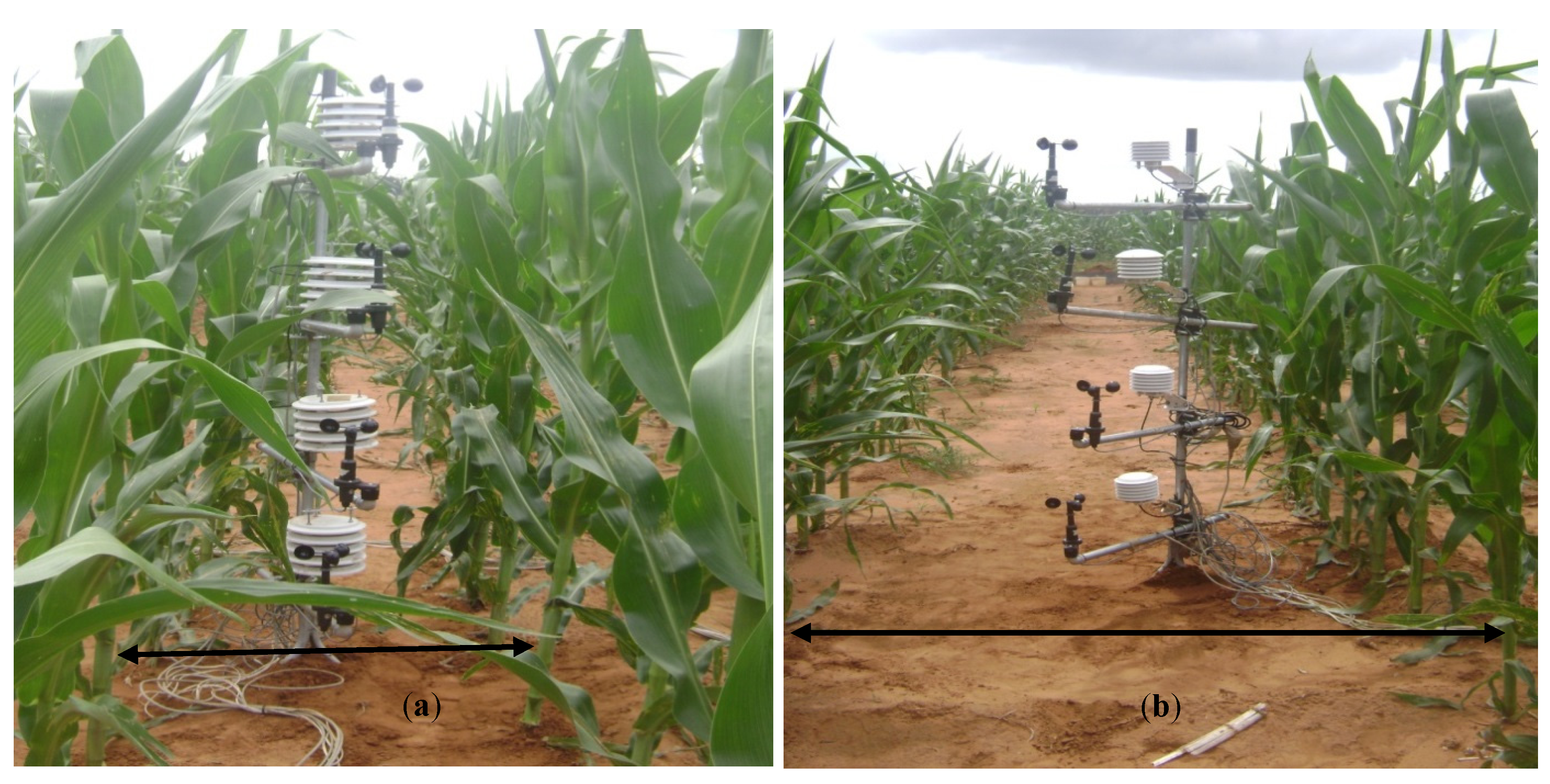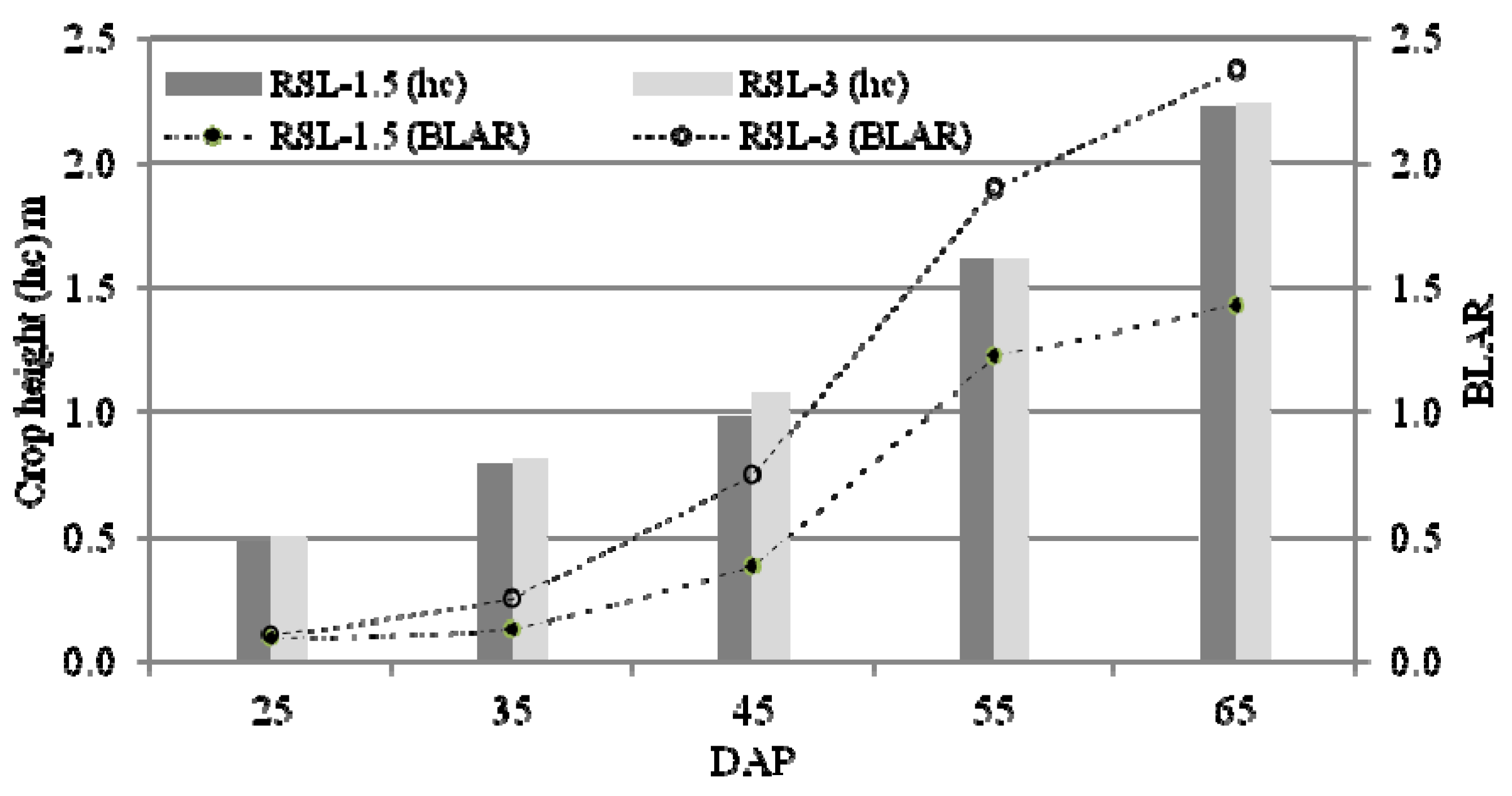Water Vapor, Temperature and Wind Profiles within Maize Canopy under in-Field Rainwater Harvesting with Wide and Narrow Runoff Strips
Abstract
:1. Introduction
2. Theoretical Basis and Description of Methods

3. Materials and Methods
3.1. Experimental Design and Layout
| Growth Stages | Early Vegetative | Late Vegetative | Maximum Height |
|---|---|---|---|
| Observed Period (Date) | 5–11 February 2009 | 20–25 February 2009 | 10–15 March 2009 |
| DOY * | 36–42 | 51–56 | 69–74 |
| Profile Position z1 (m) | 0.30 | 0.40 | 0.55 |
| Profile Position z2 (m) | 0.60 | 0.80 | 1.10 |
| Profile Position z3 (m) | 0.90 | 1.20 | 1.65 |
| Profile Position z4 (m) = hc ** | 1.20 | 1.60 | 2.20 |
3.2. Measurements

3.3. Instrumentation
3.4. Method of Statistical Analysis
4. Results and Discussion
4.1. Maize Canopy Structure

4.2. Comparison of Profiles within the Canopy
| Parameters | Layer | Early Vegetative Stage (hc = 1.2 m), n = 144 | Late Vegetative Stage (hc = 1.6 m), n = 96 | Maximum Crop Height (hc = 2.2 m), n = 120 | |||
|---|---|---|---|---|---|---|---|
| Height (m) | Significance | Height (m) | Significance | Height (m) | Significance | ||
| Wind speed (u) | LP | 0.30 | * | 0.40 | ** | 0.55 | ** |
| ML | 0.60 | ns | 0.80 | ** | 1.10 | ** | |
| MU | 0.90 | ** | 1.20 | ** | 1.65 | ** | |
| UP | 1.20 | ns | 1.60 | ** | 2.20 | ** | |
| Virtual potential temperature (θν) | LP | 0.30 | ** | 0.40 | * | 0.55 | ns |
| ML | 0.60 | ** | 0.80 | * | 1.10 | ns | |
| MU | 0.90 | ns | 1.20 | * | 1.65 | * | |
| UP | 1.20 | ** | 1.60 | ** | 2.20 | * | |
| Water vapor pressure (ea) | LP | 0.30 | ** | 0.40 | ** | 0.55 | ** |
| ML | 0.60 | ns | 0.80 | ** | 1.10 | ** | |
| MU | 0.90 | ns | 1.20 | ** | 1.65 | ** | |
| UP | 1.20 | ** | 1.60 | ** | 2.20 | ** | |
4.3. Diurnal Changes in Profile
4.3.1. Early Vegetative Growth Stage


4.3.2. Late Vegetative Growth Stage

4.3.3. Maximum Canopy Height

4.4. Relationships of Micrometeorological Variables

5. Conclusions
Acknowledgments
Conflicts of Interest
References
- Hensley, M.; Bennie, A.T.P.; van Rensburg, L.D.; Botha, J.J. Review of “plant available water” aspects of water use efficiency under irrigated and dryland conditions. Water SA 2011, 37, 771–780. [Google Scholar]
- Botha, J.J.; Anderson, J.J.; Macheli, M.; van Rensburg, L.D.; van Staden, P.P. Water Conservation Techniques on Small Plots in Semi-Arid Areas to Increase Crop Yields. In Proceedings of Symposium/Workshop on Water Conservation Technologies for Sustainable Dryland Agriculture in Sub-Saharan Africa, Bloemfontein, South Africa, 8–11 April 2003; pp. 127–133.
- Joseph, L.F.; van Rensburg, L.D.; Botha, J.J. Technical Evaluation of Water Harvesting Techniques. In Review on Rainwater Harvesting and Soil Water Conservation Techniques for Crop Production in Semi-Arid Areas; Nova Science Publishers: New York, NY, USA, 2011; pp. 15–21. [Google Scholar]
- Stigter, C.J. Rural Response to Climate Change in Poor Countries. In Sustaining Soil Productivity in Response to Global Climate Change: Science, Policies, and Ethics; Sauer, T.J., Norman, J.M., Sivakumar, M.V.K., Eds.; Wiley-Blackwell: West Sussex, UK, 2010; pp. 35–38. [Google Scholar]
- Stigter, C.J.; Weiss, A. In quest of tropical micrometeorology for on-farm weather advisories. Agric. For. Meteorol. 1986, 36, 289–296. [Google Scholar] [CrossRef]
- Arya, S.P. Introduction to Micrometeorology, 2nd ed.; Academic Press: San Diego, CA, USA, 2001; p. 420. [Google Scholar]
- Tesfuhuney, W.A.; Walker, S.; van Rensburg, L.D. Comparison of energy available for evapotranspiration under in-field rainwater harvesting with wide and narrow runoff strips. Irrig. Drain. 2012, 61, 59–69. [Google Scholar] [CrossRef]
- Rosenberg, N.J.; Blad, B.L.; Verma, S.B. Air Temperature and Heat Transfer. In Microclimate: The Biological Environment; Wiley (Inter-Science): New York, NY, USA, 1983; pp. 124–133. [Google Scholar]
- Monteith, J.L; Unsworth, M.H. Principles of Environmental Physics, 2nd ed.; Edward Arnold: Sevenoaks, UK, 1990; p. 291. [Google Scholar]
- Ni, W. A coupled transilience model for turbulent air flow within plant canopies and the planetary boundary layer. Agric. For. Meteorol. 1997, 86, 77–105. [Google Scholar] [CrossRef]
- Meyers, T.; Paw U., K.T. Modelling the plant canopy micrometeorology with higher-order closure principles. Agric. For. Meteorol. 1987, 41, 143–163. [Google Scholar] [CrossRef]
- Savage, M.J.; Everson, C.S.; Metelerkamp, B.R. Evaporation Measurement above Vegetated Surfaces Using Micrometeorological Techniques; Report No. 349/1/97; Water Research Commission: Pretoria, South Africa, 1997. [Google Scholar]
- Stull, R.B. Mean Boundry Layer Characterstics. In An Introduction to Boundary Layer Meteorology; Kluwer Academic Publishers: Dordrecht, The Netherlands, 1988; pp. 7–21. [Google Scholar]
- Plate, E.J. Aerodynamic Characteristics of Atmospheric Boundary Layers; US Department of Energy: Springfield, CA, USA, 1971; p. 190.
- Busch, N.E. On the Mechanics of Atmospheric Turbulence. In Workshop on Micrometeorology; Haugen, D.A., Ed.; American Meteorological Society: Boston, MA, USA, 1973; pp. 1–65. [Google Scholar]
- Panofsky, H.A.; Dutton, J.A. Atmospheric Tturbulence: Models and Methods for Engineering Applications; John Wiley: New York, NY, USA, 1984; p. 397. [Google Scholar]
- Malek, E. Comparison of the Bowen ratio-energy balance and stability-corrected aerodynamic methods for measurement of evapotranspiration. Theor. Appl. Climatol. 1993, 48, 167–178. [Google Scholar] [CrossRef]
- Arya, S.P.S. Atmospheric Boundary Layer over Homogenous Terrain. In Engineering Meteorology; Plate, E.J., Ed.; Elsevier: New York, NY, USA, 1982; pp. 223–267. [Google Scholar]
- Campbell Scientific. CR10 Measurement and Control Mode, Instruction Manual; Campbell Scientific Ltd.: Leicestershire, UK, 1994; p. 187. [Google Scholar]
- SAS Institute Inc. SAS Enterprise Guide 4.1 (4.1.0.471), SAS Institute Inc.: Cary, NC, USA, 2006.
- Tesfuhuney, W.A. Optimizing Runoff to Basin Area Ratios for Maize Production with in-Field Rainwater Harvesting. Ph.D. Thesis, University of the Free State, Bloemfontein, South Africa, 2012. [Google Scholar]
- Shaw, R.H.; Schumann, U. Large-eddy simulation of turbulent flow above and within a forest. Bound.-Layer Meteorol. 1992, 61, 47–64. [Google Scholar] [CrossRef]
- Wilson, J.D.; Ward, D.P.; Thurtell, G.W.; Kidd, G.E. Statistics of atmospheric turbulence within and above a corn canopy. Bound.-Layer Meteorol. 1982, 24, 495–519. [Google Scholar] [CrossRef]
- Stigter, C.J.; Birnie, J; Jansen, P. Multi-point temperature measuring equipment for crop environment, with some results on horizontal homogeneity in a maize crop 1: Field results. Neth. J. Agric. Sci. 1976, 24, 223–237. [Google Scholar]
- Raupach, M.R. Anomalies in flux-gradient relationships over forest. Bound.-Layer Meteorol 1979, 16, 467–486. [Google Scholar]
- Denmead, O.T.; Bradley, E.F. On scalar transport in plant canopies. Irrig. Sci. 1987, 8, 131–149. [Google Scholar]
- Hernandez, G.; Trabue, S.; Sauer, T.; Pfeiffer, R.; Tyndall, J.C. Odor mitigation with tree buffers: Swine production case study. Agric. Ecosyst. Environ. 2012, 149, 154–163. [Google Scholar] [CrossRef]
- Jacobs, A.F.G.; Nieveen, J.P. Formation of dew and the drying process within crop canopies. Meteorol. Appl. 1995, 2, 249–256. [Google Scholar] [CrossRef]
- Ham, J.M.; Heilman, J.L. Aerodynamic and surface resistances affecting energy transport in a sparse crop. Agric. For. Meteorol. 1991, 53, 267–284. [Google Scholar] [CrossRef]
© 2013 by the authors; licensee MDPI, Basel, Switzerland. This article is an open access article distributed under the terms and conditions of the Creative Commons Attribution license (http://creativecommons.org/licenses/by/3.0/).
Share and Cite
Tesfuhuney, W.A.; Walker, S.; Van Rensburg, L.D.; Everson, C.S. Water Vapor, Temperature and Wind Profiles within Maize Canopy under in-Field Rainwater Harvesting with Wide and Narrow Runoff Strips. Atmosphere 2013, 4, 428-444. https://doi.org/10.3390/atmos4040428
Tesfuhuney WA, Walker S, Van Rensburg LD, Everson CS. Water Vapor, Temperature and Wind Profiles within Maize Canopy under in-Field Rainwater Harvesting with Wide and Narrow Runoff Strips. Atmosphere. 2013; 4(4):428-444. https://doi.org/10.3390/atmos4040428
Chicago/Turabian StyleTesfuhuney, Weldemichael A., Sue Walker, Leon D. Van Rensburg, and Colin S. Everson. 2013. "Water Vapor, Temperature and Wind Profiles within Maize Canopy under in-Field Rainwater Harvesting with Wide and Narrow Runoff Strips" Atmosphere 4, no. 4: 428-444. https://doi.org/10.3390/atmos4040428




